2 - Electricity
1/48
Earn XP
Description and Tags
Name | Mastery | Learn | Test | Matching | Spaced |
|---|
No study sessions yet.
49 Terms
Electrical conductors
Materials that conduct charge easily - current can flow through
Usually metals e.g. copper + silver
Electrical insulators
Don’t conduct charge very well - current can’t flow
e.g. plastic + rubber
Static charge
Charge which builds up in one place and is not free to move
More common on insulators, where current can’t flow
Electrostatic charge
Common cause of static electricity is friction
When two insulating materials are rubbed together, electrons are scraped off one and dumped on the otherLeaves a +ve electrostatic charge on one and -ve electrostatic charge on the other
Which way electrons are transferred depends on two materials involved
Static charge on conductors
Static charges can occur on conductors too - cars often get static charge on outside because they gain/lose electrons from air rushing past them
Charged conductor can be discharged safely by connecting to earth with metal strap
Electrons flow down strap to ground if charge is negative and flow up the strap from ground if charge is positive
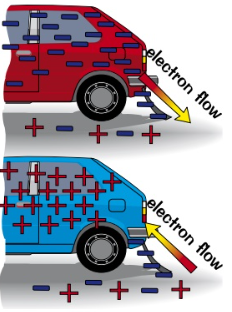
Experiment: charging insulating materials by friction
Static charges can be caused by friction
e.g. polythene + acetate rods being rubbed with cloth duster
When polythene rod is rubbed with duster, electrons move from duster to rod
Rod becomes negatively charged + duster is left with equal positive chargeWhen acetate rod is rubbed, electrons move from rod to duster
Duster becomes negatively charged + rod is left with equal positive charge
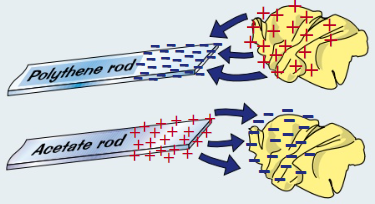
Laws of attraction
Unlike charges attract
Like charges repel

Sparks
As electric charge builds on isolated object, voltage between object and earth (0 volts) increases
If voltage gets large enough, electrons can jump across gap - spark
Can also jump to any earthed conductor nearby - which is why you can get static shocks from clothes, or getting out of a car
Usually happens when gap is small
Lightning
Rain drops + ice bump together inside storm clouds, knocking off electrons → top of cloud = positively charged, bottom of cloud = negative
Creates huge voltage + big spark
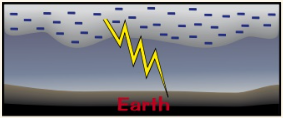
Fuelling
As fuel flows out of filler pipe, static can build up
Can easily lead to spark
Solution: make nozzles out of metal so charge is conducted away instead of building up
Have earthing straps between fuel tank and fuel pipe
Inkjet printer
Tiny ink droplets are forced out of fine nozzle, making them electrically charged
Droplets are deflected as they pass between two oppositely charged metal plates
Droplets are attracted to plate of opposite charge + repelled from plate with same charge
Size + direction of voltage across each plate changes so each droplet is deflected to hit different place on paper
Lots of tiny dots make up printout
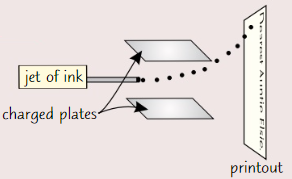
Photocopier
Image plate is positively charged
Image of what you’re copying is projected onto itWhiter bits of what you’re copying make light fall on plate and charge leaks away in those places
Charged bits attract negatively charged black powder, transferred onto positively charged paper
Paper heated so powder sticks
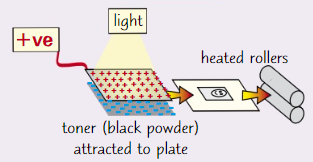
Series circuits
Components connected in a line, end to end, between +ve and -ve of power supply
If you remove/disconnect one component, circuit is broken + all stop working
Not very useful, only a few things are practically connected in series e.g. fairy lights
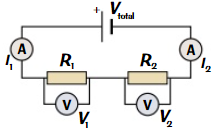
Voltage in series circuit
There’s a bigger supply p.d. when more cells are connected in series
Total p.d. of supply is shared between components
p.d. of each component depends on its resistance
Current in series circuit
Current same everywhere, I₁ = I₂
Size of current depends on total p.d. and total resistance of circuit
Resistance in series circuit
Total resistance of circuit depends on number + type of components
Total resistance is sum of resistance of each component in circuit
Parallel circuits
Each component is separately connected to +ve and -ve of supply
If you remove/disconnect one component, others are hardly affected
This is how most things are connected
e.g. cars and household electrics
Each light switch in your house is part of branch of parallel circuit (turns one light on/off)Everyday circuits often contain mixture of series and parallel parts - rules of series circuits apply to components on same branch
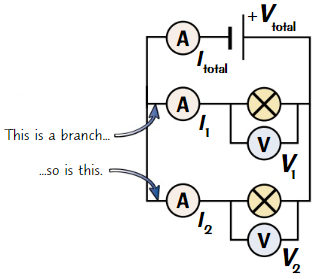
Current in parallel circuit
Current shared between branches
Total current flowing around circuit = total of all currents through separate components
There are junctions where current splits or rejoins
Total current going into junction = total current leaving it
Current through branch depends on resistance, higher resistance = lower current
Voltage in parallel circuit
P.d. is same across all branches, V₁ = V₂
Resistance in parallel circuit
Total resistance of circuit decreases if you add second resistor in parallel
Wire voltage-current characteristics
Current through wire is proportional to voltage
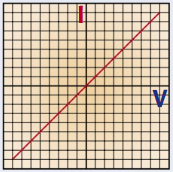
Resistor voltage-current characteristics
Current through resistor is proportional to voltage
Different resistors have different resistances

Metal filament lamp voltage-current characteristics
As temp of metal filament increases, resistance increases
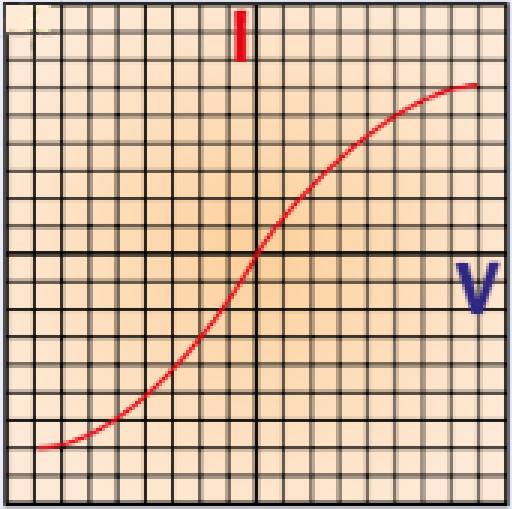
Diode voltage-current characteristics
Current only flows through diode in one direction
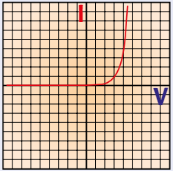
Ammeter
Measures current (in amps) through component
Must be placed in series anywhere in main circuit

Voltmeter
Measures voltage (in volts) across component
Must be placed in parallel around component
Investigating V-I characteristics
Component, ammeter and variable resistor are in series, so can be put in any order
Voltmeter must be placed in parallel around component under test
As you vary variable resistor, it alters current flowing through circuit
Allowing you to take pairs of readings from ammeter and voltmeter
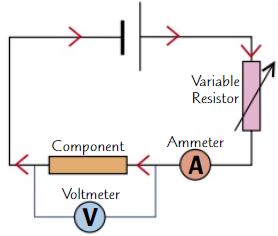
Effect of changing resistance on current
More resistance = less current
LDR
Changes resistance depending on how much light it receives
In bright light, resistance falls
In darkness, resistance is highest
Useful for various electronic circuits e.g. burglar detectors
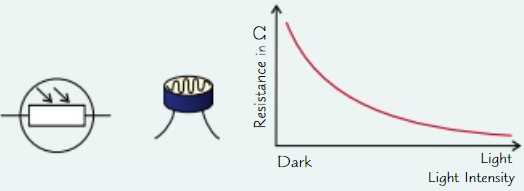
Thermistor
Temperature-dependent resistor
Hot = resistance drops
Cool = resistance increases
Useful for temperature detectors e.g. car engine temp sensors, thermostats
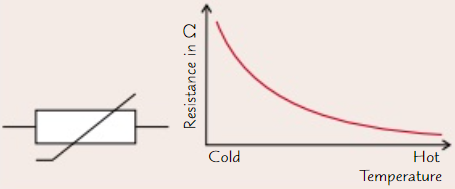
LED
Light-emitting diodes emit light when current flows through them in forward direction
Used for numbers on digital clocks and traffic lights
Unlike light bulb, don’t have filament that can burn out

LEDs and lamps can be used to…
indicate presence of current in circuit
Often used in appliances to show they’re switched on
Equation: Voltage, Current and Resistance
V = IR
Voltage = Current x Resistance
[V] = [A] x [Ω]
![<p>V = IR</p><p>Voltage = Current x Resistance</p><p>[V] = [A] x [<span>Ω</span>]</p>](https://knowt-user-attachments.s3.amazonaws.com/8d3e5016-7bdf-45be-a3be-74364c696460.jpeg)
Current
Rate of flow of charge around a circuit
Equation: Charge, Current and Time
Q = It
Charge = Current x Time
[C] = [I] x [s]
In solid metal conductors, current is…
a flow of negatively charged electrons
Plugs
Have three wires - live, neutral, earth
Only live and neutral wires usually needed, but earth wire stops you getting hurt if something goes wrong
LIVE WIRE alternates between HIGH +VE AND -VE VOLTAGE of 230V
NEUTRAL WIRE always at 0V
Electricity normally flows in through live and neutral wire
EARTH WIRE and fuse are just for safety
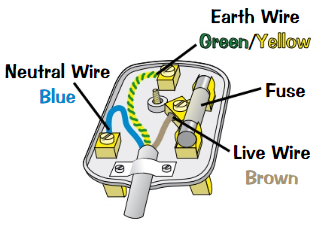
Double insulation
If appliance has plastic casing and no metal parts showing, it’s said to be double insulated
Plastic is insulator, so stops current flowing - meaning you can’t get a shock
Anything with double insulation doesn’t need earth wire
Earthing and fuses
If fault develops in which live touches metal case, then because case is earthed, big current flows through live wire, case and earth wire
Surge in current melts the fuse, cutting off the live supply
This isolates the whole appliance, making it impossible to get electric shock from case
Also prevents risk of fire caused by heating effect of large current
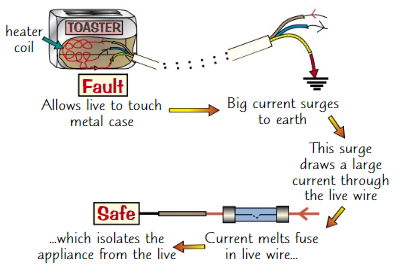
Circuit breakers
Protect circuit from damage if too much current flows
When circuit breakers detect surge in current, they break circuit by opening a switch
Circuit breaker can easily be reset by flicking a switch on the device
This makes them more convenient than fuses (have to be replaced once melted)
Heating effect in resistors
When there is electrical current in resistor, there is energy transfer which heats resistor
Because electrons collide with ions in lattice that make up resistor as they flow through it
This gives ions energy, causing them to vibrate and heat up
Heating effect increases resistor’s resistance - so less current flows
Heating effect can cause components in circuit to melt - so circuit stops working
Use of heating effect in resistors
Toasters contain coil of wire with very high resistance
When current passes through coil, temp increases so much that it glows and emits IR (heat) radiation which cooks bread
Equation: Power, Current and Voltage
P = IV
Power = Current x Voltage
[W] = [A] x [V]
Fuse ratings
Fuses have current ratings and should be rated as near as possible but just higher than the normal operating current
To work out the fuse needed, you need to work out the current that item normally uses

Equation: Energy, Current, Voltage and Time
E = IVt
Energy transferred = Current x Voltage x Time
[J] = [A] x [V] x [s]
Alternating current (a.c.)
Current is constantly changing direction
Used for mains supply, e.g. UK mains supply is approx. 230V
Direct current (d.c.)
Current keeps flowing in same direction
Used in cells and batteries
Voltage
Energy transferred per unit charge passed
One volt = one joule per coulomb
Equation: Energy, Charge and Voltage
E = QV
Energy transferred = Charge x Voltage
[J] = [C] x [V]